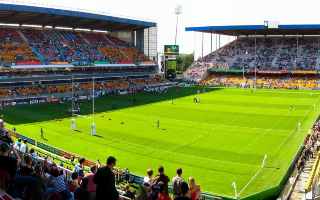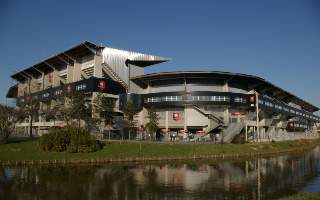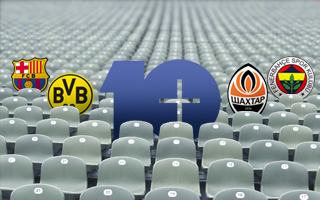Stade Bollaert-Delelis
| Capacity | 38 223 |
|---|---|
| 118 (Press seats) | |
| Country | France |
| City | Lens |
| Clubs | RC Lens |
| Inauguration | 18/06/1933 |
| Construction | 1932-1933 |
| Renovations | 1954, 1976, 1977, 1983, 1995-1997, 2014-2015 |
| Record attendance | 48 912 (Lens - Marseille, 15/02/1992) |
| Cost | €70 million (2014-2015) |
| Design | Gustave Spriet (1933), Cardete & Huet, Atelier Ferret Architectures (2014-2015) |
| Address | Avenue Alfred-Maes, BP 236, 62304 Lens Cedex |
Advertisement
Stade Bollaert-Delelis – stadium description
Its capacity is larger than number of Lens citizens, but for decades the ground has been destination to many residents of the whole region that has over half a million people. Already at the beginning of the 20th Century RC Lens were the local team, but had to move twice due to residents’ pressure and World War I destruction. Since 1920’s the club was growing strong with decision to build a new stadium in early 30’s.
Official inauguration took place in May with the symbolic playing of two anthems: French and Polish as the Polish diaspora was large in this industrial region. Poles were also among the volunteers building this ground, initiated by Felix Bollaert, the executive of French Mining Company. As he passed away in 1936, it became apparent that he is the right patron for the venue. In 2012 another patron was added, the then deceased mayor André Delelis.
Since the bonds with local industry were very tight (miners built and financed it), the situation of RC Lens and the state of the ground were also depending on the current economic situation. That’s why the ground was improving in 1950’s (floodlights installed in 1954) and then started deteriorating rapidly in 1960’s. In 1970’s a wall collapsed at the tribune of honor, sending a clear signal that work needs to be done. As the club couldn’t afford that, the stadium was transferred to the municipality. New stands came in 1976 and 1977 along with other improvements, resulting in Stade Félix Bollaert being again among best venues in France.
That opened way for a place among Euro 1984 venues. Before that tournament further works were commissioned and the ground became France’s largest until 1998 with over 51,000 capacity. It became a “British”, rectangular stadium without corner sections. Then before 1998, as World Cup hosts, the French opened Stade de France that overshadowed Bollaert, but Lens also had their share with three new stands erected at the stadium.
The revamped ground is considered very atmospheric due to Steep and robust stands, largely dictated by local constraints. But it also had serious shortcomings, which resulted in plans of further upgrade ahead of Euro 2016. All of the comprised roof was removed and replaced with new one, this time covering all spectators. It’s based on four slim pylons, 72m-tall each.
Initially there were plans to vastly expand commercial and hospitality spaces behind the southern main grandstand, but they were eventually scrapped to cut cost. The same happened with capacity, which was to grow to 44,000, but instead was slightly reduced to 38,000+. This allowed public authorities to spend €70 million rather than initially planned €111 million.
The outcome, result of over 1.5 years of work, is an elegant stadium with new white outer cladding, largely polycarbonate. Seats were replaced with white/grey/black, which resulted in some outcry by RC Lens fans disappointed in new “sanitized” décor.
How Stade Bollaert-Delelis compares to other Ligue 1 stadiums?
Advertisement
Pictures
-

09.08.2015 © Liondartois (cc: by) 
23.11.2015 © Mairie de Lens 
23.11.2015 © Mairie de Lens 
14.11.2015 © RC Lens 
14.11.2015 © RC Lens 
14.11.2015 © RC Lens 
14.11.2015 © RC Lens 
14.11.2015 © RC Lens 
2021 © passion.foot.stef 
2021 © passion.foot.stef 
2021 © passion.foot.stef 
2021 © passion.foot.stef 
03.08.2015 © RC Lens 
03.08.2015 © RC Lens 
03.08.2015 © RC Lens 
20.11.2015 © RC Lens 
20.11.2015 © RC Lens 
08.08.2015 © Liondartois (cc: by) 
23.05.2009 © Jean-Francois Garbez 
© 
© 
03.05.2014 © Stephan Hoogerwaard 
03.05.2014 © Stephan Hoogerwaard 
03.05.2014 © Stephan Hoogerwaard 
03.05.2014 © Stephan Hoogerwaard 
03.05.2014 © Stephan Hoogerwaard 
03.05.2014 © Stephan Hoogerwaard 
03.05.2014 © Stephan Hoogerwaard 
03.05.2014 © Stephan Hoogerwaard 
03.05.2014 © Stephan Hoogerwaard 
15.08.2009 © Guillaume Baviere (cc: by) 
15.08.2009 © Guillaume Baviere (cc: by) 
15.08.2009 © Guillaume Baviere (cc: by) 
12.08.2011 © crËOS (cc: by-nc-nd) 
15.08.2009 © Guillaume Baviere (cc: by) 
16.07.2010 © gtanicko (cc: by) 
31.07.2010 © gtanicko (cc: by) 
31.07.2010 © gtanicko (cc: by) 
05.02.2011 © gtanicko (cc: by)
1997-2014:
Related news
2025
2024
-

France: RC Lens on track to buy Bollaert-Delelis stadium
RC Lens president Joseph Oughourlian is considering the possibility of buying Bollaert-Delelis in what could be a landmark moment in the club's history. If the deal goes through, Lens will become one of the few clubs in France to have ownership of its stadium.
-

France: Attendance at Ligue 1 stadiums in 2023/24 season.
The French league. Some love it, others call it “farmers league”. A competition dominated by the team from Paris, and an outcome other than PSG winning a match pleases everyone else. Does chairman Al-Khelaiïfi's team have the same big advantage in the stands as on the pitch?
2022
-

France: At which stadiums will they play in Ligue 1?
The new season for the TOP 5 European leagues starts... today! On Friday, August 5, the top-level matches in England, Germany and France will kick off. It is this latter competition, and in fact its stadiums, that we will be taking an in-depth look at in this article.
-

Euro 2025: Race to host the women’s tournament heats up
Four bids are currently in the competition to become the women's Euro 2025 host. Looking at the whole process, at least one trend seems to be emerging: joined bids. Similarly to the competitions to host men’s Euro 2028 or World Cup 2030, that are shaping up, potential organisers are eager to welcome big tournaments but also look for ways to keep the costs down by joining forces.
2016
-

10+ Ranking: Europe’s most popular clubs by attendance
We’ve listed all 227 clubs that draw an average of 10,000 people or more every day. Which teams from your country are on the list?
-

Euro 2016: Record – almost 2.5 million people!
Just as predicted, Euro 2016 broke all records in terms of attendance. Not even the threat of terrorism could stop people from around the world from filling the stadiums beyond 90%.
-

Euro 2016: The largest Euro in history
Average capacity of every stadium outgrew all European Championships held in this century. Ticket number highest in history, but how does attendance look so far? Let’s see!
-

Euro 2016 Countdown: 08 – Stade Bollaert-Delelis
It was supposed to be prepared magnificently, but it’s decent at best. Still, Stade Bollaert-Delelis stands out as one of France’s most atmospheric stadiums.
-

Stadium of the Year 2015: Public Vote summary
Which nations voted most, which stadiums were selected most frequently, what average notes did they get. These are some of the questions we’ll answer here!
-

Stadium of the Year 2015: Last 48 hours to cast your vote!
We’re only two days away from the voting platform’s closing, so be sure to list your 5 favourite stadiums and vote. Already now over 34,000 people took part in this year’s vote.
-

Stadium of the Year 2015: Meet the nominee – Stade Bollaert-Delelis
One of this year’s most unique candidates, because it’s an old stadium dressed in brand new clothing. And not all supporters are crazy about the extent of changes…
-

Stadium of the Year 2015: Jury begins work along new rules
Meet our five amazing Jurors and new rules along which they’re judging all nominated stadiums. Their work has only just begun…
-

Stadium of the Year 2015: Let the vote begin!
Whether it’s a phone, laptop, or any other device, from now on you can use it to select the best stadium opened in 2015. The vote is open for one month.
-

Stadium of the Year 2015: Meet the 22 nominees!
22 stadiums from 15 countries are qualified to compete for the next Stadium of the Year 2015 title. Two awards will be given in two separate votes. Read more for details!
-

Stadium of the Year 2015: Time to submit your nominees!
From now until Friday everyone around the world is welcome to submit nominees for the Stadium of the Year 2015 award! Which stadia do you think deserve to be included?
-

Lens: New roof, old issues
The renovation project of Stade Bollaert-Delelis may have cost roughly $90 million, but issues regarding protection against rain still remain. And they’re only top of a longer list.
2015
-

Euro 2016: Group draw over, here’s the calendar
All group games now set, check out detailed times and locations here. Some tasty fixtures await in June 2016 and we can only guess who will make it to the July knock-out games.
-

France: Lens return in great numbers!
RC Lens end their season-long exile. And despite relegation they sold out Stade Bollaert-Delelis four days before the opening game!
-

10+ Ranking 2015: Attendances in Europe (Part 2. The Clubs)
Borussia, Barca and Man United – lovely dominant trio. But it wasn’t them who gained most fans last season. Check all 217 clubs that draw an average crowd of 10,000+!
 StadiumDB
StadiumDB